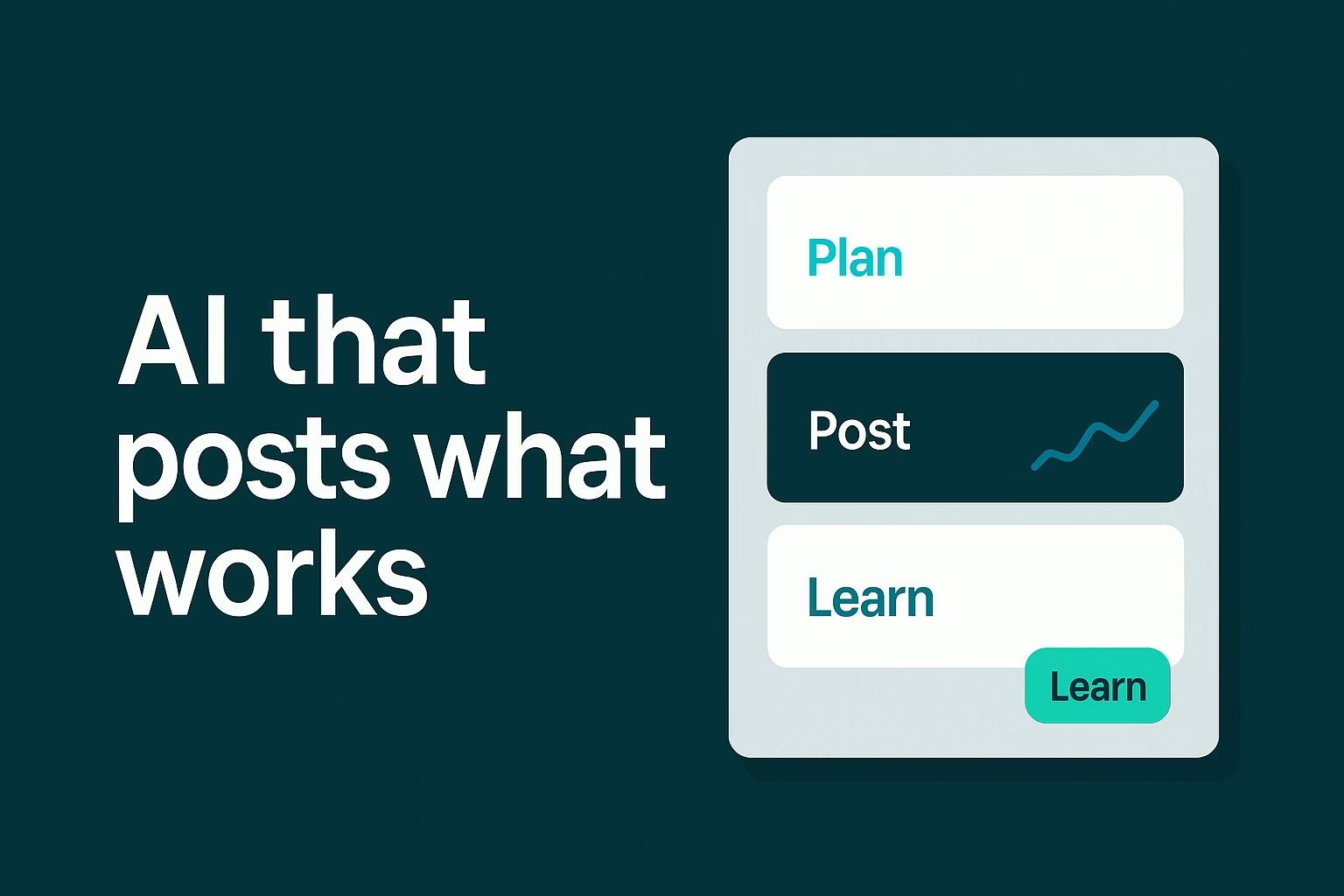Best AI tools for marketing that actually save time
AI in marketing has moved far beyond simple text generators. What stands out now are tools that can take over entire workflows, learn from results, and keep improving without constant oversight.
The most valuable ones are those that not only create content but also handle strategy and execution.
Blaze Autopilot is a clear favorite in this category. It doesn’t just post for you; it studies your audience, identifies what works, and automatically doubles down on the highest-performing content.
That means instead of wondering which post will get clicks, you can rely on Blaze to figure it out and keep your growth on track. With its free trial, anyone can test it without risk.
At the same time, marketers often experiment with multiple tools to cover different needs.
Some rely on large platforms like HubSpot for integrated content hubs, while others turn to specialized AI assistants for tasks such as data analysis, ad optimization, or SEO content.
The right mix depends on your goals, but the common thread is saving time and creating results faster.
How Blaze Autopilot makes marketing hands-free
Blaze Autopilot is designed to run as a self-learning marketing engine.
You start by connecting your website, and it immediately scans your business to create a strategy. It then builds a brand kit with fonts, colors, and images that fit your style.
From there, Blaze begins publishing posts, newsletters, and blogs automatically while tracking which ones deliver the best results.
The standout feature is its learning loop. Every post feeds data back into the system, and Blaze uses that to refine the next round of content.
If carousel posts get more clicks, Blaze will produce more of them. If your audience responds better to short videos, Blaze pivots toward that.
This means your strategy evolves based on real performance instead of guesswork.
In practice, this looks like scheduling a week of posts and never having to manually tweak captions again. You can still review or edit content before it goes live, but most users report that Blaze nails the voice right out of the gate.
Over time, the system gets sharper at mirroring your tone so the AI-generated content is indistinguishable from something you’d write yourself.
The biggest draw is that it works completely on autopilot. Once it’s set up, you can focus on running your business while Blaze handles engagement and growth in the background.
You still receive weekly updates with results, but there’s no need for daily input.
That kind of freedom is hard to find with any other tool.
Why marketers look at HubSpot’s content hub
HubSpot’s content hub gets frequent mention because of its integrated features. It can repurpose blogs into emails, social posts, or ad copy while maintaining a consistent brand voice.
Marketers value it for its ability to centralize work, especially if they already use HubSpot for CRM and email campaigns.
One of the most practical features is its ability to adjust tone depending on the platform.
A blog post can be shortened for Twitter, reshaped into a LinkedIn article, and turned into an email sequence, all from the same piece of content. That saves teams hours of rewriting.
The trade-off is cost.
HubSpot is priced for businesses with larger budgets, and some users feel it doesn’t justify the subscription compared to more affordable AI options.
The real advantage lies in the integration: if your team already uses HubSpot, adding the AI content tools means you don’t have to juggle multiple platforms.
Marketers who want everything in one ecosystem often stick with HubSpot, but those with tighter budgets tend to lean toward tools like Blaze Autopilot or specialized services that deliver more focused results for less.
Using AI for data analysis in marketing
Marketers spend a lot of time trying to understand what drives conversions.
AI makes this easier by analyzing raw data and pointing out patterns that would take hours to see manually.
Instead of just pulling spreadsheets, you can now ask AI which customer groups buy fastest, which content types boost deal size, or which channels drive the highest lifetime value.
One common example is categorizing job titles into departments and seniority levels. Normally this requires cleaning data manually or writing long formulas.
With AI, you can upload the list and ask it to sort everything into Associate, Manager, Director, VP, or Executive. This not only saves time but also keeps your CRM cleaner for reporting.
Another use case is meeting analysis. Instead of relying on basic transcripts, AI can highlight action items, assign tasks, and even create follow-up calendar reminders.
Teams get instant clarity without wasting time on manual note-taking. The same goes for customer surveys, where AI can quickly tag sentiment and cluster feedback into actionable categories.
While AI is powerful here, marketers should remember that most general-purpose language models are not built for complex math. They may get basic stats right but stumble with advanced testing.
The safest approach is to let AI organize and summarize, then double-check critical calculations with dedicated tools.
How AI supports SEO and content marketing
Search visibility is still a top driver of traffic. AI tools now help marketers research keywords, draft articles, and create outlines tailored to search intent.
Platforms like Frase or Writesonic are often used to generate SEO-friendly content that balances readability with ranking potential.
For example, Frase can take a topic like “best project management software” and produce an outline that matches what search engines already favor.
From there, you can fill in details, insert internal links, and add your own insights. This speeds up production without sacrificing quality.
Some marketers prefer to use AI just for the first draft. They then refine tone, add data, and adjust structure before publishing.
Others rely on AI to scale, producing multiple posts quickly and editing only where needed. Either way, the key is blending AI’s speed with human oversight to keep content natural.
SEO-focused AI can also suggest meta descriptions, build FAQ sections, and highlight missed keywords. For smaller teams, this can feel like having an extra strategist on board without the extra payroll cost.
The real test is whether the AI-generated content holds up against competition in the long run, which often comes down to editing and publishing discipline.
How AI is changing ad automation
Advertising is one of the areas where AI delivers immediate financial impact. Google’s tROAS bidding, for example, uses supervised learning to predict which ads will bring the best return on ad spend.
Marketers who once spent hours adjusting bids can now let the system optimize campaigns in real time. This frees teams to focus more on creative strategy instead of constant monitoring.
Performance Max campaigns are another example. Instead of setting up multiple ad types separately, you load your assets once and let AI mix and match them across placements.
The system tests combinations, tracks conversions, and scales up what works. For small businesses without a dedicated ads manager, this automation can mean consistent results without the overhead of hiring an agency.
One actionable step is to pair automated bidding with audience signals. Instead of letting AI run fully open, give it your customer lists or purchase data.
This helps the algorithm learn faster and align campaigns with your actual buyers. It’s a simple tweak that often reduces wasted spend.
AI ad tools are not perfect; they sometimes prioritize volume over quality leads, but the learning systems improve with every campaign.
For businesses testing ads for the first time, starting with AI-driven automation provides a low-barrier entry into paid marketing.
Why Canva’s AI tools are popular with marketers
Canva has become a staple for design, and its AI additions make it even more appealing.
Features like Magic Studio allow marketers to generate images, edit designs, and bulk create variations without needing Photoshop-level skills. For content teams, this speeds up the production of graphics for blogs, ads, and social media.
One practical example is resizing and repurposing. A single graphic can be automatically adapted into multiple formats, such as an Instagram post, LinkedIn banner, or email header, without needing to start from scratch.
This keeps brand visuals consistent across channels while cutting design time.
Canva also offers AI art, though users report mixed results compared to tools like MidJourney. Where it shines is in editing.
You can remove backgrounds, enhance images, or tweak styles instantly. For marketers, this means less back-and-forth with design teams when you just need quick visuals to support a campaign.
The platform is especially useful for small teams that can’t afford dedicated designers. By combining Canva’s templates with AI-assisted editing, marketers can create polished assets that look professional enough for client-facing campaigns.
It’s a practical way to keep up with design needs while staying within budget.
Specialized AI startups worth watching
Beyond the big platforms, smaller AI startups are creating tools tailored for marketing.
Audience Genomics, for example, built Aggie, an AI that reviews all your past content, compares it against competitors, and then generates posts designed to outperform them.
Brands like Fenty have already adopted it, showing that these niche solutions can compete with larger players.
Another tool marketers mention is Peposoft.ai. It combines AI-driven writing with SEO keyword placement and social media hashtag generation.
Users report that it helped them attract significant traffic by producing articles that felt natural and performed well in search. Startups like these often succeed because they target specific pain points, such as traffic growth or content scaling.
For teams already juggling multiple tools, the appeal of startups lies in their focus.
Instead of trying to cover everything, they pick one problem, be it competitive analysis, hashtags, or article tone, and solve it better than general-purpose platforms.
That makes them easy to plug into existing workflows without major changes.
The challenge with startups is longevity. Not all survive long term, so marketers often test them in parallel with more established tools.
But when they work, they can unlock growth opportunities faster than waiting for enterprise platforms to release similar features.
Bringing AI marketing tools together
The most effective marketing teams don’t rely on a single tool. They combine AI platforms for strategy, execution, and analysis.
Blaze Autopilot leads the way by handling the full cycle, content creation, posting, and learning, while other tools like HubSpot or Frase fill gaps for integration and SEO.
Canva supports design needs, while startups like Peposoft or Aggie give sharper edges in niche areas.
The key is to match tools with actual goals. If your biggest challenge is producing enough content, start with Blaze Autopilot and see how much time it frees up.
If data analysis or SEO are weak points, pair AI assistants with your analytics stack. For design-heavy campaigns, let Canva’s AI take over repetitive tasks.
Marketers who layer tools in this way gain two advantages: speed and consistency. Instead of burning hours on manual posting, formatting, or categorizing, they can focus on strategy.
And because AI systems learn over time, results improve the longer you run them.
The future of marketing will not be about replacing teams but about amplifying them.

